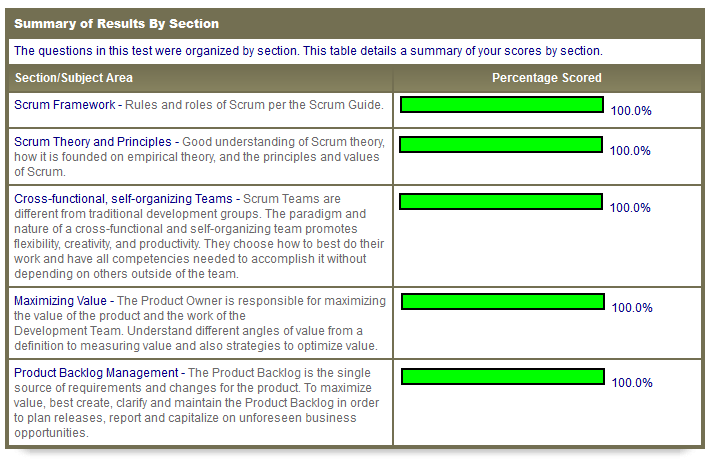
PSPO Certification is a great way of validating the Scrum and Product Ownership knowledge. To pass the PSPO I, you have to get an 85% score or higher on an 80-question time test in 60 minutes, similar to the Scrum Open assessment. The central role of the Scrum Team is the Product Owner role whose responsibilities are Optimize Return on Investment (ROI) and Total Cost of Ownership (TCO) for the Development Team’s work. Along with other responsibilities are creating and sustaining a Product Backlog that maximizes value and represents the needs of the stakeholders. Purchase Udemy or Techagilist Paid Membership to access PSPO Questions with helpful explanations.
PSPO Certification Subject Areas
The scrum Product Owner is responsible for maximizing the value of the product resulting from the work of the Development Team. There are five subject areas. Therefore each subject area covers a specific topic.
Knowledge areas tested in PSPO are roughly divided into the below-mentioned percentages
- Scrum Framework and Scrum Theory: 25%
- Roles and Responsibilities: 25%
- Product Backlog Management: 15%
- Cross-Functional and Self-Organization Team: 15%
- Maximizing the Value of the Product and Development Team: 10%
- Product Ownership in scaled Scrum: 5%
- Miscellaneous: 5%
PSPO Certification Focus Areas
- Understanding and Applying the Scrum Framework (Empiricism, Scrum Team, Scrum Events, Scrum Artifacts, Done)
- Developing People and Teams (Self-Managing Teams)
- Managing Products with Agility (Forecasting and Release Planning, Product Vision, Product Value, Product Backlog Management, Business Strategy, Stakeholders, and Customers)

Learning Objectives
Fundamentals that are essential for understanding and satisfying the role of the Product Owner in the context of product management and Scrum.
- Values of agile development
- Responsibilities of Product Owner
- Appropriate meetings with the Product Owner
- Compulsions of the Product Owner
- Leadership qualities of the Product Owner
- Understanding of business values incl. KPIs
A practical approach to teaching the methodological skills the Product Owner needs for successfully handling a Scrum project.
- Measuring business value
- Product build-up
- Relevance of user stories
- Setting and achieving strategic product goals
- Release strategies and planning with Scrum
- Estimating and prioritizing requirements
- Forecasting capability with Scrum
- Product development involving multiple teams
- The total cost of ownership
PSPO Certification Exam Format
- Number of questions: 80
- Duration: 1 hour
- Type of questions: multiple choice (with one or more correct answers) and true/false
- Passing Score: 85% (yes, it’s really high)
- Open book: yes
- Price: $200
- Prerequisite: none
- Needs renewal: no
- Recommended Practice Exam – Click Here
PSPO Certification Tips and Tricks
- Read and thoroughly understand the Scrum Guide.
- Read the Scrum.org official guidelines and linked documents for the Product Owner Learning Path.
- Use the Open Assessments for practice for PSM and PSPO. Take the Product Owner Open until you achieve 100% repeatedly (5 times in a row). Take the Scrum Open and Developer Open assessments to increase your knowledge and familiarity with the Scrum.org assessment style.
- A few concepts are not in Scrum Guide but come up in the exam.
- Cone of Uncertainty
- Definition of Done.
- Definition of Ready.
- Burndown Charts.
- Suggested Reading.
- Evidence-Based Management (EBM) and its four Key Value Areas (KVAs)
- Scaled Agile (Nexus Framework) and how to operate and coordinate multiple Scrum teams
- Find the concept that you are not clear about in Scrum.org Forum.
- Learn about the uses of Poker Planning, burn-down and burn-up charts, and how scrum works with multiple teams.
- Read the Scrum Glossary, and refer back to it when necessary.
- Be careful with questions containing “NOT”: some questions ask, for example, “which of the following is NOT a characteristic of…”, and many people forget about the “NOT”, and pick the wrong answer. Similarly careful phrasing like “should vs. could”, “attend vs. participate”, “can”, “must”, and “may” as well as other wordings.
- Be careful with multiple-answer questions: some questions ask you to choose multiple answers, and some people just don’t pay enough attention and pick one answer. All multiple-answer questions use checkboxes instead of radio buttons; get used to paying attention to this as a double-check. Therefore it’s a good idea to spend a few minutes at the end of the exam, going through all the questions and only checking to see if you’ve picked multiple answers where you needed.
- Answer all questions: As there are no negative points for wrong answers so attempt all the questions.
- Strategy for tackling difficult questions:
- Eliminate answers that break the rules of Scrum
- From the remaining options, select the answer that provides the best chance of delivering tangible value. In some cases, this is the “least bad” option.
Frequently Asked Questions
Question: How many levels are there in the Professional Scrum Product Owner (PSPO)?
Answer: PSPO has three levels: Foundation, Practitioner, and Master.
- The Foundation level (PSPO I) is perfect if you’re new to PSPO or agile in general. It will give you a good understanding of the basics and key concepts of the PSPO framework.
- The Practitioner level (PSPO II) is ideal if you want to deepen your knowledge and learn how to apply PSPO in a real-world setting. You’ll also learn how to adapt the PSPO framework to specific situations and challenges.
- If you’re an experienced agile practitioner, then the Master level (PSPO III) is for you. This advanced level will test your knowledge and skills to the fullest, and upon successful completion, you’ll be able to take on complex projects and lead PSPO initiatives.
Purchase PSPO Practice Exams (650 Questions – 5 sets of 100 Questions & 1 set of 150 Questions) Click Here for UDEMY or TechAgilist Paid Membership.
Recommended Practice Exams
- Scrum.org
- PSM I – PSM Practice Exam Real Mode Questions
- PSM I – PSM Practice Exam Practice Mode Questions
- PSM II – PSM II Practice Exam Practice Mode Questions
- PSPO I – PSPO Practice Exam Real Mode Questions
- PSPO I – PSPO Practice Exam Practice Mode Questions
- PSPO II – PSPO II Practice Exam Practice Mode Questions
- PSD – PSD Practice Exam Practice Mode Questions
- SPS – SPS Practice Exam Practice Mode Questions
- Scrum Alliance
- PMI
Disclaimer: Professional Scrum™, Professional Scrum Master, PSM, PSM I, Professional Scrum Product Owner, PSPO, PSPO I, Scrum Open, etc. is the protected brand of Scrum.org. Our content and practice exams are neither endorsed by nor affiliated with Scrum.org. All the content related to Scrum Guide is taken from scrumguides.org and is under the Attribution ShareAlike license of Creative Commons. Further information is accessible at https://creativecommons.org/licenses/by-sa/4.0/legalcode and also described in summary form at http://creativecommons.org/licenses/by-sa/4.0/.

